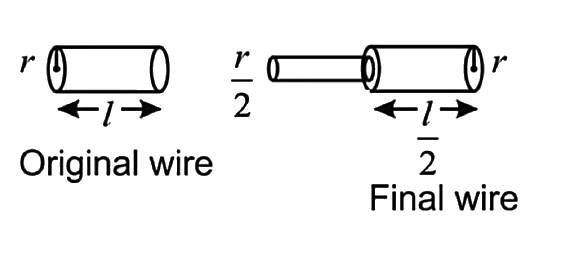One end of a horizontal thick copper wire of length 2L and radius 2R is weded to an end of another horizontal thin copper wire of length L and radius R .When the arrangement is stretched by applying forces at two ends , the ratio of the elongation in the thin wire to that in the thick wire is
0.25
0.50
2.00
4.00
The correct Answer is:C
To solve the problem of finding the ratio of the elongation in the thin wire to that in the thick wire, we can follow these steps:
Step 1: Identify the parameters of the wires
- Thick Wire (Wire 1):
- Length, L1=2L
- Radius, R1=2R
- Area of cross-section, A1=π(R1)2=π(2R)2=4πR2
- Thin Wire (Wire 2):
- Length, L2=L
- Radius, R2=R
- Area of cross-section, A2=π(R2)2=πR2
Step 2: Write the formula for elongation
The elongation (Δl) of a wire when a force F is applied is given by the formula:
Δl=F⋅LA⋅Y
where:
- F is the force applied,
- L is the length of the wire,
- A is the area of cross-section,
- Y is the Young's modulus of the material.
Step 3: Calculate elongation for both wires
- Elongation of the thick wire (Wire 1):
Δl1=F⋅L1A1⋅Y=F⋅(2L)(4πR2)⋅Y=2FL4πR2Y=FL2πR2Y
- Elongation of the thin wire (Wire 2):
Δl2=F⋅L2A2⋅Y=F⋅L(πR2)⋅Y=FLπR2Y
Step 4: Find the ratio of elongations
Now, we need to find the ratio of elongation in the thin wire to that in the thick wire:
Δl2Δl1=FLπR2YFL2πR2Y=FLπR2Y⋅2πR2YFL=2
Conclusion
The ratio of the elongation in the thin wire to that in the thick wire is:
Δl2Δl1=2
Final Answer
Thus, the answer is 2 (Option 3).
---
- Thick Wire (Wire 1):
- Length, L1=2L
- Radius, R1=2R
- Area of cross-section, A1=π(R1)2=π(2R)2=4πR2
- Length, L2=L
- Radius, R2=R
- Area of cross-section, A2=π(R2)2=πR2
The elongation (Δl) of a wire when a force F is applied is given by the formula:
Δl=F⋅LA⋅Y
where:
- F is the force applied,
- L is the length of the wire,
- A is the area of cross-section,
- Y is the Young's modulus of the material.
- Elongation of the thick wire (Wire 1):
Δl1=F⋅L1A1⋅Y=F⋅(2L)(4πR2)⋅Y=2FL4πR2Y=FL2πR2Y
Δl2=F⋅L2A2⋅Y=F⋅L(πR2)⋅Y=FLπR2Y
Now, we need to find the ratio of elongation in the thin wire to that in the thick wire:
Δl2Δl1=FLπR2YFL2πR2Y=FLπR2Y⋅2πR2YFL=2
The ratio of the elongation in the thin wire to that in the thick wire is:
Δl2Δl1=2
Thus, the answer is 2 (Option 3).
Topper's Solved these Questions
- ELASTICITYBOOK - DC PANDEY ENGLISHCHAPTER - ELASTICITYEXERCISE - Level 1 Subjective
8 Videos
- ELASTICITYBOOK - DC PANDEY ENGLISHCHAPTER - ELASTICITYEXERCISE - Level 2 Single Correct
10 Videos
- ELASTICITYBOOK - DC PANDEY ENGLISHCHAPTER - ELASTICITYEXERCISE - Assertion And Reason
22 Videos
- CURRENT ELECTRICITYBOOK - DC PANDEY ENGLISHCHAPTER - CURRENT ELECTRICITYEXERCISE - All Questions
469 Videos
- ELECTROSTATICSBOOK - DC PANDEY ENGLISHCHAPTER - ELECTROSTATICSEXERCISE - Integer
17 Videos
Similar Questions
Two wires of the same material and length are stretched by the same force. Their masses are in the ratio 3:2. Their elongations are in the ratio
View SolutionTwo wires of the same material and same mass are stretched by the same force. Their lengths are in the ratio 2:3. Their elongation are in the ratio
View Solution
Knowledge Check
One end of a horizontal thick copper wire of length 2L and radius 2R is welded to an end fo another horizontal thin copper wire of lenth L and radius R. When the arrangement is stretched by applying forces at two ends, the ratio of the elongation in the thin wire to that in the thick wire is
A0.25BÂ 0.50CÂ 2.00D4.00
A force F is required to break a wire of length L and radius r. Find the force required to break a wire of the same material, length 2L and radius 4r.
View SolutionA wire of length l has a resistance R. If half of the length is stretched to make the radius half of its original value, then the final resistance of the wire is

View SolutionOne end of a Nichrome wire of length 2L and cross-sectional area A is attached to an end of another Nichrome wire of length L and cross-sectional area 2A. If the free end of the longer wire is at an electric potential of 8.0 volts, and the free end of the shorter wire is at an electric potential 1.0 volts, the potential at the junction of the two wires is equal to
View SolutionA force F is needed to break a copper wire having radius R. The force needed to break a copper wire of same length and radius 2R will be
View SolutionTwo wires of copper having the length in the ratio 2:1 and their radii ratio as 1:2 are stretched by the same force. The ratio of longitudinal strain in the two will be
View SolutionTwo steel wires of the same radius have their lengths in the ratio of 1:2. If they are stretched by the same force, then the strains produced in the two wires will be in the ratio of
View SolutionA uniform wire of length L and radius r is twist by an angle α. If modulus of rigidity of the wire is η, then the elastic potential energy stored in wire
View Solution
